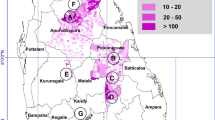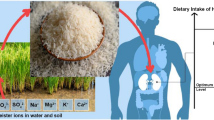Abstract
Ingestion of toxic trace elements in the human body has been considered one of the major reasons for renal dysfunction. Chronic kidney disease with uncertain etiological factors (CKDu) is a recently described clinical entity in which the disease is found in geographically isolated pockets in the dry zone of Sri Lanka. In CKDu regions, an increasing number of cases are reported with acute interstitial nephritis without any known reason (AINu). However, recent exposure to certain risk behaviors or nephrotoxins, or both, is suspected for the AINu. Consumption of foods that are contaminated with trace elements is one of the main pathways of human exposure to environmental toxins. The current study was carried out to assess the possibility of trace element–contaminated rice consumption on the etiopathogenesis of AINu. Samples of rice consumed by 32 clinically diagnosed AINu cases were collected and analyzed for possible nephrotoxic trace elements. Out of 32 patients, 26 were histologically confirmed with tubulointerstitial disease. The results revealed that the mean values of Cd, As, and Pb were 0.18, 0.055, and 0.135 mg/kg, with ranges of 0.020–1.06, 0.012–0.222, and 0.003–0.744 mg/kg (on dry weight basis), respectively. This study indicated that the investigated toxic trace element levels of rice consumed by AINu were reasonably below the recommended levels of the Codex Alimentarius Commission of FAO and WHO. Hence, it is less likely that rice consumption is to be a risk factor for the etiology of AINu.

Similar content being viewed by others
Data Availability
The data set used or analyzed during the current study is not publicly available due to the pending examination of the postgraduate student (SP), but is available with the corresponding author upon a reasonable request.
References
Moe S, Drüeke T, Cunningham J, Goodman W, Martin K, Olgaard K, Ott S, Sprague S, Lameire N, Eknoyan G (2006) Definition, evaluation, and classification of renal osteodystrophy: a position statement from Kidney Disease: Improving Global Outcomes (KDIGO). Kidney Int 69:1945–1953. https://doi.org/10.1038/sj.ki.5000414
Inker LA, Astor BC, Fox CH, Isakova T, Lash JP, Peralta CA, Tamura MK, Feldman HI (2014) KDOQI US commentary on the 2012 KDIGO clinical practice guideline for the evaluation and management of CKD. American Journal of Kidney Diseases 63(5):713–735
Elledge MF, Redmon JH, LevineKE, Wickremasinghe RJ, Wanigasariya KP, Peiris-John RJ (2014) Chronic kidney disease of unknown etiology in Sri Lanka: quest for understanding and global implications. RTI Press. https://doi.org/10.3768/rtipress.2014.rb.0007.1405
Weaver VM, Fadrowski JJ, Jaar BG (2015) Global dimensions of chronic kidney disease of unknown etiology (CKDu): a modern era environmental and/or occupational nephropathy? BMC nephrology 16(1):145. https://doi.org/10.1186/s12882-015-0105-6
Chandrajith R, Nanayakkara S, Itai K, Aturaliya TNC, Dissanayake CB, Abeysekera T, Harada K, Watanabe T, Koizumi A (2011) Chronic kidney diseases of uncertain etiology (CKDue) in Sri Lanka: geographic distribution and environmental implications. Environ Geochem Health 33:267–278. https://doi.org/10.1007/s10653-010-9339-1
Athuraliya NTC, Abeysekera TDJ, Amerasinghe PH, Kumarasiri R, Bandara P, Karunaratne U, Milton AH, Jones AL (2011) Uncertain etiologies of proteinuric-chronic kidney disease in rural Sri Lanka. Kidney Int 80:1212–1221. https://doi.org/10.1038/ki.2011.258
Fernando WBNT, Hettiarachchi TW, Sudeshika T, Badurdeen Z, Abeysundara H, Ranasinghe S, Rathnayake MP, Nanayakkara N (2019) Snap shot view on anaemia in chronic kidney disease of uncertain aetiology. Nephrology 24:1033–1040. https://doi.org/10.1111/nep.13545
Vlahos P, Schensul SL, Nanayakkara N, Chandrajith R, Haider L, Anand S, Silva KJ, Schensul JJ (2019) Kidney progression project (KiPP): protocol for a longitudinal cohort study of progression in chronic kidney disease of unknown etiology in Sri Lanka. Glob Public Health 14:214–226. https://doi.org/10.1080/17441692.2018.1508480
Balasooriya S, Munasinghe H, Herath AT, Diyabalanage S, Ileperuma OA, Manthrithilake H, Daniel C, Amann K, Zwiener C, Barth JAC (2020) Possible links between groundwater geochemistry and chronic kidney disease of unknown etiology (CKDu): an investigation from the Ginnoruwa region in Sri Lanka. Exposure and Health 12:823–834. https://doi.org/10.1007/s12403-019-00340-w
Badurdeen Z, Nanayakkara N, Ratnatunga NVI, Wazil AWM, Abeysekera TDJ, Rajakrishna PN, Thinnarachchi JP, Kumarasiri R, Welagedera DD, Rajapaksha N (2016) Chronic kidney disease of uncertain etiology in Sri Lanka is a possible sequel of interstitial nephritis. Clin Nephrol 86:106. https://doi.org/10.5414/CNP86S115
Anand S, Montez-Rath ME, Adasooriya D, Ratnatunga N, Kambham N, Wazil A, Wijetunge S, Badurdeen Z, Ratnayake C, Karunasena N, Schensul SL, Valhos P, Haider L, Bhalla V, Levin A, Wise PH, Chertow GM, Barry M, Fire AZ, Nanayakkara N (2019) Prospective biopsy-based study of CKD of unknown etiology in Sri Lanka. Clin J Am Soc Nephrol 14:224–232. https://doi.org/10.2215/cjn.07430618
Nanayakkara S, Komiya T, Ratnatunga N, Senevirathna STMLD, Harada KH, Hitomi T, Gobe G, Muso E, Abeysekera T, Koizumi A (2012) Tubulointerstitial damage as the major pathological lesion in endemic chronic kidney disease among farmers in North Central Province of Sri Lanka. Environ Health Prev Med 17:213–221. https://doi.org/10.1007/s12199-011-0243-9
Wijetunge S, Ratnatunga NVI, Abeysekera TDJ, Wazil AWM, Selvarajah M (2015) Endemic chronic kidney disease of unknown etiology in Sri Lanka: correlation of pathology with clinical stages. Indian J Nephrol 25:274–280. https://doi.org/10.4103/0971-4065.145095
Fischer RSB, Vangala C, Mandayam S, Chavarria D, García-Trabanino R, Garcia F, Garcia LL, Murray KO (2018) Clinical markers to predict progression from acute to chronic kidney disease in Mesoamerican nephropathy. Kidney Int 94:1205–1216. https://doi.org/10.1016/j.kint.2018.08.020
Premarathne S, Nanayakkara N, Chandrajith R, Rathnayake R, Rathnathunga N, Badurdeen Z, Abeysundara H, Elladeniya N, Guruge K, Madushan S (2020) The possible link between undetermined chronic kidney disease (CKDu) and acute interstitial nephritis (AIN) in the dry zone regions of Sri Lanka. Nephrol Dial Transplant 35(gfaa142):P0224. https://doi.org/10.1093/ndt/gfaa142.P0224
Chawla LS, Eggers PW, Star RA, Kimmel PL (2014) Acute kidney injury and chronic kidney disease as interconnected syndromes. N Engl J Med 371:58–66. https://doi.org/10.1056/NEJMra1214243
Diyabalanage S, Navarathna T, Abeysundara HTK, Rajapakse S, Chandrajith R (2016) Trace elements in native and improved paddy rice from different climatic regions of Sri Lanka: implications for public health. Springerplus 5:1864. https://doi.org/10.1186/s40064-016-3547-9
Jayalal TBA, Bandara TWMAJ, Mahawithanage STC, Wansapala MAJ, Galappaththi SPL (2019) A quantitative analysis of chronic exposure of selected heavy metals in a model diet in a CKD hotspot in Sri Lanka. BMC Nephrol 20:208. https://doi.org/10.1186/s12882-019-1371-5
Rajatheja MKJC, Chandrajith R, Bentota A, Jayasinghe GY (2021) A comparative assessment of trace element accumulation in native and improved rice (Oryza sativa L.) varieties grown under different conditions of fertilizer application. Biol Trace Elem Res 199:1153–1160. https://doi.org/10.1007/s12011-020-02213-9
Dissanayake CB, Chandrajith R (1999) Medical geochemistry of tropical environments. Earth Sci Rev 47:219–258. https://doi.org/10.1016/S0012-8252(99)00033-1
Balasooriya S, Diyabalanage S, Yatigammana SK, Ileperuma OA, Chandrajith R (2021) Major and trace elements in rice paddy soils in Sri Lanka with special emphasis on regions with endemic chronic kidney disease of undetermined origin. Environ Geochem Health. https://doi.org/10.1007/s10653-021-01036-4
Liu L, Han J, Xu X, Xu Z, Abeysinghe KS, Atapattu AJ, De Silva PMCS, Lu Q, Qiu G (2020) Dietary exposure assessment of cadmium, arsenic, and lead in market rice from Sri Lanka. Environ Sci Pollut Res 27:42704–42712. https://doi.org/10.1007/s11356-020-10209-0
FAO/WHO (2012) Proposed draft maximum levels for arsenic in rice. Report of the Codex Committee of Food Additives and Contaminants, 6th Session of Joint FAO/WHO food standards programme Maastricht, The Netherlands, 26-30 March 2021. https://doi.org/10.13140/RG.2.1.3879.0884
Meharg AA, Norton G, Deacon C, Williams P, Adomako EE, Price A, Zhu Y, Li G, Zhao F-J, McGrath S, Villada A, Sommella A, De Silva PMCS, Brammer H, Dasgupta T, Islam MR (2013) Variation in rice cadmium related to human exposure. Environ Sci Technol 47:5613–5618. https://doi.org/10.1021/es400521h
Hou G, Surhio MM, Ye H, Gao X, Ye Z, Li J, Ye M (2019) Protective effects of a Lachnum polysaccharide against liver and kidney injury induced by lead exposure in mice. Int J Biol Macromol 124:716–723. https://doi.org/10.1016/j.ijbiomac.2018.11.133
Tomsa AM, Alexa AL, Junie ML, Rachisan AL, Ciumarnean L (2019) Oxidative stress as a potential target in acute kidney injury. PeerJ 7:e8046. https://doi.org/10.7717/peerj.8046
Lentini P, Zanoli L, Granata A, Signorelli SS, Castellino P, Dell’Aquila R (2017) Kidney and heavy metals-the role of environmental exposure. Mol Med Rep 15:3413–3419. https://doi.org/10.3892/mmr.2017.6389
Hu H, Téllez-Rojo MM, Bellinger D, Smith D, Ettinger AS, Lamadrid-Figueroa H, Schwartz J, Schnaas L, Mercado-García A, Hernández-Avila M (2006) Fetal lead exposure at each stage of pregnancy as a predictor of infant mental development. Environ Health Perspect 114:1730–1735. https://doi.org/10.1289/ehp.9067
Fischer RSB, Unrine JM, Vangala C, Sanderson WT, Mandayam S, Murray KO (2020) Evidence of nickel and other trace elements and their relationship to clinical findings in acute Mesoamerican Nephropathy: a case-control analysis. PLoS ONE 15:e0240988. https://doi.org/10.1371/journal.pone.0240988
Hussain S, Rengel Z, Qaswar M, Amir M, Zafar-ul-Hye M (2019) Arsenic and heavy metal (cadmium, lead, mercury and nickel) contamination in plant-based foods. In: Ozturk M., K. H (eds) Plant and Human Health (Volume 2). Springer, Cham., pp 447–490. https://doi.org/10.1007/978-3-030-03344-6_20
Orr SE, Bridges CC (2017) Chronic kidney disease and exposure to nephrotoxic metals. Int J Mol Sci 18:1039. https://doi.org/10.3390/ijms18051039
Abeywickrama HM, Koyama Y, Uchiyama M, Shimizu U, Iwasa Y, Yamada E, Ohashi K, Mitobe Y (2018) Micronutrient status in Sri Lanka: a review. Nutrients 10:1583. https://doi.org/10.3390/nu10111583
Messaoudi I, El Heni J, Hammouda F, Saïd K, Kerkeni A (2009) Protective effects of selenium, zinc, or their combination on cadmium-induced oxidative stress in rat kidney. Biol Trace Elem Res 130:152–161. https://doi.org/10.1007/s12011-009-8324-y
Branca JJV, Morucci G, Pacini A (2018) Cadmium-induced neurotoxicity: still much ado. Neural Regen Res 13:1879. https://doi.org/10.4103/1673-5374.239434
Halder D, Saha JK, Biswas A (2020) Accumulation of essential and non-essential trace elements in rice grain: possible health impacts on rice consumers in West Bengal. India Science of The Total Environment 706:135944. https://doi.org/10.1016/j.scitotenv.2019.135944
Emumejaye K (2014) Heavy and trace elements in some brands of rice consumed in delta state, Nigeria. IOSR Journal of Applied Physics 6:01–05
Chamannejadian A, Sayyad G, Moezzi A, Jahangiri A (2013) Evaluation of estimated daily intake (EDI) of cadmium and lead for rice (Oryza sativa L.) in calcareous soils. Iran J Environ Health Sci Eng 10:28. https://doi.org/10.1186/1735-2746-10-28
Huang Z, Pan X-D, Wu P-G, Han J-L, Chen Q (2013) Health risk assessment of heavy metals in rice to the population in Zhejiang, China. PloS one 8(9):e75007. https://doi.org/10.1371/journal.pone.0075007
Funding
This research work was conducted with the financial support from the National Science Foundation (Grant No.: RPHS/2016/CKDu/06).
Author information
Authors and Affiliations
Contributions
Conceptualization: SP, RC, and NN; methodology: SP, RC, and NN; formal analysis: SS, NE, SG, and KO; sample preparation: PH and KP; data analysis: DH; interpretation of biopsies with scoring: NR; original draft preparation: SP; reviewing and editing: RC, NN, CD, NR, SP, ZB, and SW; and fund acquisition: RC, CDG, and NN.
Corresponding author
Ethics declarations
Ethics Approval and Consent to Participate
The ethical clearance for the study was obtained from the Ethical Review Committee of the Faculty of Medicine, University of Peradeniya, Sri Lanka (2015/EC/32). Consent to participate in the study was taken in writing before the recruitment.
Conflict of Interest
The authors declare no competing interests.
Additional information
Publisher’s Note
Springer Nature remains neutral with regard to jurisdictional claims in published maps and institutional affiliations.
Could Consumption of Trace Element–Contaminated Rice Be a Risk Factor for Acute Interstitial Nephritis with Uncertain Etiology in the Dry Zone of Sri Lanka?
Supplementary Information
Below is the link to the electronic supplementary material.
Rights and permissions
About this article
Cite this article
Premarathne, S., Chandrajith, R., Nanayakkara, N. et al. Could Consumption of Trace Element–Contaminated Rice Be a Risk Factor for Acute Interstitial Nephritis with Uncertain Etiology in the Dry Zone of Sri Lanka?. Biol Trace Elem Res 200, 2597–2605 (2022). https://doi.org/10.1007/s12011-021-02880-2
Received:
Accepted:
Published:
Issue Date:
DOI: https://doi.org/10.1007/s12011-021-02880-2




